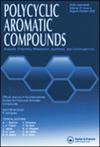Synthesis of 4-Azaindole-Thiazolidine-2,4-Dione Coupled 1,2,3-Triazoles as EGFR Directing Anticancer Agents
IF 2.4
3区 化学
Q2 CHEMISTRY, ORGANIC
引用次数: 0
Abstract
Herein, we synthesized some new 4-azaindole-thiazolidine-2,4-dione-1,2,3-triazole hybrids (6a-6n) via Knoevenagel condensation and copper(I) catalyzed azide-alkyne cycloaddition (CuAAC) as key approaches. These hybrids were then screened for their in vitro anticancer activity against three human cancer cell lines like MCF-7 (breast), A549 (lung) and HepG2 (hepatocellular) using erlotinib as standard drug. Out of all, compounds 6a, 6k and 6m were found to be more active against all cell lines with IC50 values <18 µM. As well, compounds 6a (IC50 = 0.40 µΜ), 6k (IC50 = 0.29 µΜ) and 6m (IC50 = 0.18 µΜ) showed higher potency ininhibiting tyrosine kinase EGFR than the erlotinib (IC50 = 0.41 µΜ). Further, molecular dockingof compounds 6a, 6k and 6 m on EGFR protein revealed that they have good binding energies with the target protein (−9.96 kcal/mol, −9.92 kcal/mol and −10.37 kcal/mol respectively) which were found to be supportive with the corresponding in vitro activities data.
4-Azaindole-Thiazolidine-2,4-Dione Coupled 1,2,3-Triazoles as EGFR Directing Anticancer Agents 的合成
在此,我们通过 Knoevenagel 缩合和铜(I)催化叠氮-炔环加成(CuAAC)作为关键方法,合成了一些新的 4-氮杂吲哚-噻唑烷-2,4-二酮-1,2,3-三唑杂化物(6a-6n)。然后,以厄洛替尼为标准药物,筛选了这些杂交化合物对 MCF-7(乳腺癌)、A549(肺癌)和 HepG2(肝癌)等三种人类癌细胞系的体外抗癌活性。在所有化合物中,化合物 6a、6k 和 6m 对所有细胞株都具有较高的活性,其 IC50 值为 18 µM。此外,与厄洛替尼(IC50 = 0.41 µΜ)相比,化合物 6a(IC50 = 0.40 µΜ)、6k(IC50 = 0.29 µΜ)和 6m(IC50 = 0.18 µΜ)在抑制酪氨酸激酶表皮生长因子受体(EGFR)方面表现出更高的效力。此外,化合物 6a、6k 和 6 m 与表皮生长因子受体蛋白的分子对接显示,它们与目标蛋白的结合能良好(分别为 -9.96 kcal/mol、-9.92 kcal/mol 和 -10.37 kcal/mol),这与相应的体外活性数据相吻合。
本文章由计算机程序翻译,如有差异,请以英文原文为准。
求助全文
约1分钟内获得全文
求助全文
来源期刊

Polycyclic Aromatic Compounds
化学-有机化学
CiteScore
3.70
自引率
20.80%
发文量
412
审稿时长
3 months
期刊介绍:
The purpose of Polycyclic Aromatic Compounds is to provide an international and interdisciplinary forum for all aspects of research related to polycyclic aromatic compounds (PAC). Topics range from fundamental research in chemistry (including synthetic and theoretical chemistry) and physics (including astrophysics), as well as thermodynamics, spectroscopy, analytical methods, and biology to applied studies in environmental science, biochemistry, toxicology, and industry. Polycyclic Aromatic Compounds has an outstanding Editorial Board and offers a rapid and efficient peer review process, as well as a flexible open access policy.
 求助内容:
求助内容: 应助结果提醒方式:
应助结果提醒方式:


